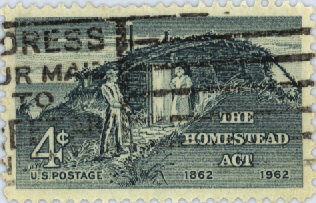Opportunities Open In The West
A mere quarter-century later, virtually all the country had been carved into states and territories. Settlement was spurred by the Homestead Act of 1862, which granted free farms of 64 hectares to citizens who would occupy and improve the land. By 1880 the Act had placed nearly 22,400,000 hectares into private hands. Conflicts with the Indians had come to an end. Miners had ranged over the whole of the mountain country, tunneling into the earth, establishing little communities in Nevada, Montana, and Colorado. Cattlemen, taking advantage of the enormous grasslands, had laid claim to the huge expanse stretching from Texas to the upper Missouri River. Sheepmen, too, had found their way to the valleys and mountain slopes. Farmers swarmed into the plains and valleys and closed the gap between the east and west. By 1890, the frontier had disappeared. Five or six million men and women now farmed where buffalo had roamed only two decades before.
 Speeding this settlement were the railroads. In 1862,
Congress voted a charter to the Union Pacific Railroad, which pushed
westward from Council Bluffs, Iowa. At the same time, the Central
Pacific began to build eastward from Sacramento, California. The
whole country was stirred as the two lines steadily approached
each other, finally meeting on May 10, 1869, at Promontory
Point in Utah. The months of laborious travel hitherto separating
the two oceans was now cut to a fraction of that time. The
continental rail network grew steadily, and by 1884 four great lines
linked the central Mississippi Valley area with the Pacific.
Speeding this settlement were the railroads. In 1862,
Congress voted a charter to the Union Pacific Railroad, which pushed
westward from Council Bluffs, Iowa. At the same time, the Central
Pacific began to build eastward from Sacramento, California. The
whole country was stirred as the two lines steadily approached
each other, finally meeting on May 10, 1869, at Promontory
Point in Utah. The months of laborious travel hitherto separating
the two oceans was now cut to a fraction of that time. The
continental rail network grew steadily, and by 1884 four great lines
linked the central Mississippi Valley area with the Pacific.
The first great rush of population to the far west was drawn to the mountainous regions, where gold was found in California in 1848, in Colorado and Nevada 10 years later, in Montana and Wyoming in the 1860s, and in the Black Hills of the Dakota country in the 1870s. Miners opened up the country, established communities, and laid the foundations for more permanent settlements. Yet even while digging in the hills, some settlers perceived the region's farming and stock-raising possibilities. Eventually, though a few communities continued to be devoted almost exclusively to mining, the real wealth of Montana, Colorado, Wyoming, Idaho, and California proved to be in the grass and soil.
Cattle-raising, long an important industry in Texas, became even more flourishing after the war, when enterprising men began to drive their Texas longhorns north across the open public domain. Feeding as they went, the cattle arrived at railway shipping points in Kansas, larger and fatter than when they started. Soon this "long drive" became a regular event, and, for hundreds of kilometers, trails were dotted with herds of cattle moving northward. Cattle-raising spread into the trans-Missouri region, and immense ranches appeared in Colorado, Wyoming, Kansas, Nebraska, and the Dakota territory. Western cities flourished as centers for the slaughter and dressing of meat.
Ranching introduced a colorful mode of existence with the picturesque cowboy as its central figure. "We led a free and hardy life with horse and with rifle," wrote Theodore Roosevelt, twenty-fifth President of the United States, in reminiscence of his own experiences in Dakota.
"We worked under the scorching midsummer sun when the wide plains shimmered and wavered in the heat; and we knew the freezing misery of riding night guard round the cattle in the late fall roundup. . .. But we felt the beat of hardy life in our veins and ours was the glory of work and the joy of living."
Altogether, between 1866 and 1888, some six million head of cattle were driven up from Texas to winter on the high plains of Colorado, Wyoming, and Montana. The cattle boom reached its height by 1885, then the range became too heavily pastured to support the long drive, and was beginning to be criss-crossed by railroads. Not far behind the rancher creaked the prairie schooners of the farmers bringing their families, their draft horses, cows, and pigs. Under the Homestead Act they staked their claims and fenced them with barbed wire. Ranchmen were ousted from lands they had roamed without legal title. Soon the romantic "wild west" had ceased to be.
